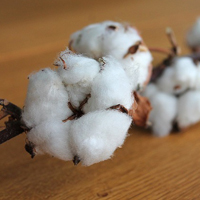Variability and inheritance of fiber length and wilt resistance in a complex 4-5 specific and backcross hybridization of cotton

Accepted: February 2, 2021
All claims expressed in this article are solely those of the authors and do not necessarily represent those of their affiliated organizations, or those of the publisher, the editors and the reviewers. Any product that may be evaluated in this article or claim that may be made by its manufacturer is not guaranteed or endorsed by the publisher.
In this paper presents data of researches about fiber length in the 4-5 species. The largest number of plants with the indicated analyzed trait in hybrid combinations, obtained with the participation of the variety Omad, appeared with a number of variations in fiber length at 35.0-36.0 mm and above. Investigation of 4-species hybrids of F2 and back cross hybridization allowed some improvement in the average value of trait when compared with F1. Despite the emergence of transgressive plants with fiber length 36.1-37.0 mm and above, the average trait of composite 5 species hybrids F2 remained almost at the level of F1, i.e. 35.5-36.0 mm. The greatest number of positive recombinants occurred in 5 species back crossing developed with the participation of Termez-31.
Abdullaev AA, Klyat VP, Rizaeva SM. Evolutionary and historical aspects of natural and artificial selection to improve early maturity of cotton. Evolutionary and selection aspects, early maturity and adaptability of cotton and other crops: Proceedings of an international scientific conference. Tashkent, Uzbekistan Academy of Sciences: FAN, 2005:9-12. (Russian)
Abdullaev AA, Omelchenko MB, Lazereva N. Potential for creating genus Gossypium- base promising cotton varieties. Khlopkovodstvo 1980;8:29-31. (Russian)
Endrizzi JE, Turcotte EL, Kohel RJ. Genetics, cytology and evolution of gossypium. Adv Gen 1985;23:271-375. DOI: https://doi.org/10.1016/S0065-2660(08)60515-5
Grover CE, Gallagher JP, Jareczek JJ, et al. Re-evaluating the phylogeny of allopolyploid Gossypium L. Mol Phylogenet Evol 2015;92:45-52. DOI: https://doi.org/10.1016/j.ympev.2015.05.023
Arutyunova L, Pulatov M. Interspecific hybridization – create the original source material for breeding and replenish the gene pool of cotton. Genetika, selektsiya i semenovodstvo khlopchatnika i lyutserny, Tashkent: 1989:43-50. (Russian)
Babamuratov H. Inheritance of some morphological and agronomic traits in the progeny of a three-specific cotton hybrids. Ph.D. Thesis in Cotton Science, Tashkent: 1982:24. (Russian)
Mirakhmedov S.M. Razrabotka metoda vyvedeniya viltoustoychivykh sortov khlopchatnika i vnedreniye ikh v proizvodstvo. Genetika khlopchatnika, Tashkent: 1972:89-97.
Namazov Sh. E. Character formation in the progeny of interspecific hybrid G. thurberi Tod.xG.raimondii Ulbr. by crossing them with varieties of specie G. hirsutumL. Ph.D. Thesis in Cotton Science, Tashkent: 1996:24. (Russian).
Pulatov M. Interspecific hybridization in cotton genetics and breeding (Review), Tashkent: 1993:22.
Mirakhmedov SM. Razrabotka metoda vyvedeniya viltoustoychivykh sortov khlopchatnika i vnedreniye ikh v proizvodstvo. Genetika khlopchatnika, Tashkent: 1972:89-97.
Dospekhov BA. Metodika polevogo opyta. Moscow: Kolos, 1985:351. (Russian)
PAGEPress has chosen to apply the Creative Commons Attribution NonCommercial 4.0 International License (CC BY-NC 4.0) to all manuscripts to be published.


 https://doi.org/10.4081/jbr.2021.9243
https://doi.org/10.4081/jbr.2021.9243



